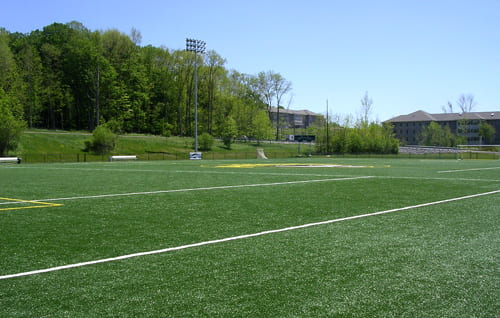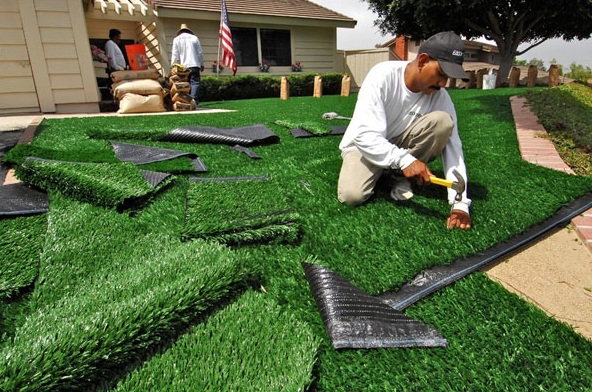Explore the Environmental Advantages of Opting for Artificial Turf Solutions
The fostering of synthetic grass solutions offers a compelling opportunity to resolve pressing environmental obstacles. By substantially reducing water use and reducing the application of hazardous chemicals, these choices not just promote lasting landscape design however also shield regional ecosystems. In addition, the reduced carbon footprint connected with decreased upkeep activities adds to a more lasting method to land monitoring. The ramifications of these advantages extend beyond plain conservation efforts, raising concerns regarding their lasting impact on habitat preservation and total ecological balance. Checking out these measurements reveals a complex interplay worth taking into consideration.
Water Conservation Advantages
One of the most considerable advantages of synthetic grass is its ability to conserve water. Traditional grass yards call for significant watering, particularly in areas prone to dry spell or water constraints. On the other hand, man-made grass does not need watering, significantly reducing the total need for water resources. This feature is specifically beneficial in deserts where water scarcity is a pushing problem.
By eliminating the demand for routine watering, fabricated grass adds to sustainable landscape techniques and helps alleviate the ecological effect of too much water consumption. Additionally, the conservation of water prolongs to the decrease of runoff, which can cause dirt erosion and river pollution.
In addition, the installation of synthetic grass allows homeowners and towns to designate water sources more effectively, concentrating on crucial uses such as drinking water and agriculture. The shift in the direction of fabricated turf not only promotes accountable water usage however additionally straightens with more comprehensive environmental goals focused on preserving natural resources.
As neighborhoods progressively focus on sustainability, the water preservation advantages of man-made lawn offer a compelling case for its adoption in commercial and residential landscaping projects.
Reduced Chemical Use
The change to synthetic grass significantly lowers the dependence on chemical therapies frequently utilized in natural turf maintenance. Traditional turf monitoring commonly entails the application of pesticides, herbicides, and plant foods to promote growth and control pests. These chemicals can posture threats to human health and wellness, local wild animals, and the setting, contributing to soil and water contamination.
In comparison, man-made grass eliminates the demand for these dangerous compounds. Once mounted, it needs minimal maintenance, mainly including routine cleaning and seldom infill replenishment. This reduction in chemical use not only profits the instant environment yet also adds to wider eco-friendly stability. By minimizing the launch of artificial compounds right into the environment, synthetic grass promotes much healthier soil and water supply.
Additionally, the lack of chemical overflow related to synthetic grass installments helps secure local waterways from pollution, sustaining aquatic life and preserving biodiversity. Arizona artificial turf. As communities increasingly focus on lasting techniques, opting for synthetic grass offers a viable service that lines up with ecological preservation objectives. Via this shift, residential property proprietors can enjoy lush green areas without jeopardizing environmental wellness, leading the means for an extra lasting future
Reduced Carbon Impact

Additionally, the setup of synthetic grass can result in substantial water conservation. Natural lawns need significant amounts of water for irrigation, which not only includes in the carbon footprint connected with water extraction and treatment however likewise stress regional water sources. On the other hand, man-made grass needs very little maintenance, requiring no watering, thus considerably decreasing water usage and its associated energy costs.
In addition, the long life of fabricated lawn contributes to its lower carbon influence. With a life-span of approximately 15 years or even more, the need for frequent substitutes is directory lessened, causing less waste and lower power intake in manufacturing and throwing away standard turf alternatives. Overall, synthetic grass provides a sustainable alternative for ecologically mindful landscaping.
Environment Preservation
Environment conservation is a vital consideration in the argument over landscaping choices, especially when contrasting synthetic grass to natural lawn. Natural yard yards typically require considerable maintenance, consisting of making use of pesticides, herbicides, and plant foods, which can detrimentally impact neighborhood communities. These chemicals can seep into the dirt and waterways, hurting indigenous plants and animals and disrupting local environments.
Synthetic grass gets rid of the requirement for damaging chemicals, consequently securing close-by wildlife and preserving the stability of surrounding communities. The installation of artificial turf can lead to the conversion of previous yard locations right into more biodiverse landscapes, such as investigate this site pollinator gardens or indigenous plant locations, which can sustain regional wildlife.
Ultimately, the change to fabricated lawn not just saves water and decreases maintenance initiatives yet likewise promotes a more unified partnership between human activities and the native environment, advertising habitat conservation at the same time.
Long-Term Sustainability
Long-lasting sustainability is an important element in evaluating the benefits of synthetic grass over typical lawn lawns. Among the most significant advantages of synthetic turf is its durability; it can last approximately 15-20 years with minimal upkeep, whereas natural grass needs frequent reseeding and substitute. This longevity lowers the requirement for constant sources, such as water, fertilizers, and chemicals, which are vital for preserving a healthy turf lawn.
Furthermore, synthetic grass contributes to a decrease in carbon emissions connected with grass care tools. Standard grass commonly call for gas-powered mowers, leaners, and blowers, all of which add to air contamination. Artificial turf companies phoenix. In comparison, synthetic grass gets rid of the demand for such equipment, advertising a cleaner environment
In addition, the production of artificial grass progressively makes use of recycled materials, boosting its sustainability profile. As producers take on environment-friendly practices, the environmental impact of synthetic grass remains to lessen.

Conclusion
The fostering of synthetic lawn options presents substantial environmental benefits, including significant water conservation, lowered reliance on unsafe chemicals, and a reduced carbon impact. Artificial grass help in preserving natural environments by minimizing land disturbance and advertising long-term sustainability through the usage of sturdy materials. Collectively, these variables underscore the capacity of synthetic grass to contribute favorably to ecological health and use a sensible option to typical landscaping methods in a significantly resource-conscious world.
In contrast, man-made lawn does not need watering, substantially lowering the overall demand for water sources. By minimizing the launch of artificial compounds right into the ecological community, synthetic grass advertises healthier dirt and water systems.
Furthermore, the installment of artificial lawn can result in substantial water conservation. In contrast, synthetic turf needs minimal maintenance, requiring no watering, thereby considerably decreasing water usage and its associated energy costs.

Comments on “Enjoy a Flawless Lawn with Arizona Artificial Turf for Any Outdoor Space”